M113 armoured personnel carriers in Australian service
The Australian Army has operated large numbers of M113 armoured personnel carriers since 1964. Between 817 and 840 M113s were acquired between 1965 and 1979, comprising nine different variants. A long-running modernisation program which commenced in the 1990s resulted in 431 being upgraded between 2007 and 2012.
The M113 has been the main type of armoured fighting vehicle used by the Australian Army for most of its career, and has equipped dedicated armoured transport units and mechanised infantry formations. It has also been used as a support vehicle by many other units. The type played an important role in Australia's commitment to the Vietnam War between 1965 and 1972. Small numbers of M113s were deployed to Somalia during 1992 and 1993 and Rwanda in 1994 and 1995. Larger numbers of M113s operated in East Timor between 1999 and 2002.
Despite the upgrade program, the M113s are now becoming obsolete and the Army has not used them in recent deployments due to their vulnerability to attack. A project to replace the M113s with infantry fighting vehicles is underway, and the new vehicles are scheduled to enter service from 2025.
Acquisition
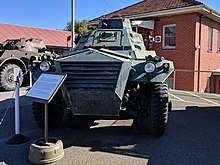
The M113s were acquired as part of an initiative launched by Chief of the General Staff Lieutenant-General Sir Ragnar Garrett in 1958 to modernise the Army's organisation and equipment so that it was compatible with those of Australia's allies, particularly the United States Army.[1] Other new equipment issued to the Army during the early 1960s as part of this program included FN FAL rifles, M60 machine guns, M2A2 howitzers, M40 recoilless rifles and mortars and radios.[2] 1 As part of the adoption of the Pentropic organisation in 1960 the Army needed to acquire APCs for its armoured units. This organisation included two APC regiments, the 12th/16th Hunter River Lancers and the 8th/13th Victorian Mounted Rifles.[3] Each regiment was authorised 119 APCs.[4] A further two APCs were to be issued to each armoured regiment and nine were to form part of the equipment of the two divisional reconnaissance squadrons.[5] The reconnaissance regiment in the Pentropic divisions' combat support group was to have 25 APCs.[6]
A formal Weapons Equipment Policy Statement specifying that the Army required tracked APCs was issued on 26 June 1960.[7] The statement called for the Army to acquire tracked APCs which were amphibious and could be carried by aircraft.[8] These vehicles were to replace the Army's wheeled scout cars and APCs which had been purchased in the 1950s, as well as obsolete AFVs dating from the Second World War.[8][9]
The American M113, the British FV432 and the Canadian Bobcat were considered. The Bobcat was the least advanced and no prototype had been completed, so it was rejected prior to trials being conducted.[7] From November 1962 to April 1963, two prototype FV432s and two production M113s were subjected to trials in hot and dry conditions at Mount Isa, Queensland and hot and wet conditions at Mourilyan, Queensland. The British Ministry of Defence (MOD) played an active role in these trials, and it was particularly interested in the outcomes of tropical trials of the FV432.[10]
The trials began with crew familiarisation and driver training on both types in the Innisfail area. Once this was complete, the four trial vehicles were driven in convoy the 1,100 kilometres (680 mi) to Mount Isa to conduct hot and dry trials. These included automotive and physiological tests, the latter of particular interest to the MOD.[10] Testing in extreme heat during this phase found the poor ventilation of the M113 took a heavy toll on crew and passengers of the type, and one driver lost 5 kilograms (11 lb) in two hours. The FV432's forced air ventilation system proved superior in this aspect.[11] At the conclusion of this stage of the trials the vehicles were driven a longer 1,200 kilometres (750 mi) route back to Innesfail for the hot and wet phase of the trials at nearby Mourilyan. This phase included extensive driving through jungles and on sandy beaches, amphibious testing and being left to the elements unattended for 14 days.[12] The M113 outperformed the FV432 in almost every aspect tested; its smooth sides and roof stowage proved far superior when driving through overgrown jungle, the lower track pressure and better track design proved superior on sand and it was significantly more waterproof.[12] When conducting amphibious trials, whilst slightly slower in the water the M113 required significantly less time to prepare. The FV432's amphibious preparations included the removal of every inspection plate and the erection of a large rubber flotation screen, the latter was seen as a major drawback as it completely blocked the driver's vision and the rubber screen was easily punctured by debris or vegetation.[12]
The trials demonstrated that the M113 was much better suited to the Army's requirements than the FV432, and accordingly the M113 was selected for service.[9][7] Despite this several improvements to the type were recommended prior to final acceptance. These modifications included the installation on a ventilation system. In coordination with engineers from the vehicle's manufacturer FMC, a ventilation system unique to Australian vehicles was developed. Orders were placed during the 1963–64 financial year.[12][13] At this time, it was planned to retain the M113s until 1995.[14]
The M113A1 variant was ordered for the Army, with the first deliveries scheduled for 1964.[8][13] This vehicle had a crew of two and could carry up to eleven passengers. Its armour provided protection against small arms and shrapnel.[15] While US Army M113s were powered by a petrol engine, the Australian Army selected the M113A1 variant which used General Motors V6 diesel engines. This was because the variant had greater range, the diesel fuel was less likely to combust if the APC was damaged in combat and the same engine was used to power buses, which meant that spare parts were readily available.[7][16] The Australian M113A1s were initially armed with a single pintle-mounted 0.5 inch calibre M2 Browning heavy machine gun.[17]
Deliveries of the M113 began in 1964, but proved slow.[18] The first M113s to arrive included specialist variants, including fitters vehicles (which carried maintenance personnel) and mortar carriers.[19] They began to be issued to Royal Australian Armoured Corps (RAAC) units on 19 March 1965.[13] The M113s initially replaced the Army's Alvis Saracen wheeled APCs.[18] Reserve Citizen Military Forces (CMF) units were accorded a low priority, with some not receiving M113s until the late 1960s.[20] Deliveries of the M113s were completed in 1979.[21]
M113A1 variants and modifications
M113A1 variants
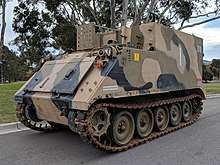
The original orders of M113s included several variants:
- M125A1: These vehicles are fitted with a single 81 mm mortar, and are based on the M113A1. The mortar is mounted inside the rear hull on a turntable, and racking is fitted inside the vehicle for mortar ammunition.[16] The M125A1 is armed with a M2 Browning for self protection.[16]
- M113A1 Fitters vehicle: These vehicles are also based on the M113A1 and are used to repair equipment in combat areas. They are fitted with a hydraulic crane on their roof capable of lifting an engine and transmission pack. The vehicles also carry tools, spare parts and technicians.[22] They are armed with a M2 Browning.[16]
- M113 Armoured Recovery Vehicle Light: This variant was used to recover other vehicles from the field[23]
- M557A1 Armoured Command Vehicle: This variant has a raised rear hull to accommodate working spaces for headquarters staff. The working space can be further extended by erecting a canvas tent. The M557A1 was originally armed with a 0.3 inch M1919 Browning machine gun, though a M60 machine gun was sometimes fitted instead.[24]
- M548 Tracked Load Carrier: The M548 is an unarmoured logistics variant of the M113. The type was acquired to replace the wheeled logistics carriers within armoured units.[25]
Vietnam-era modifications
Operational experience in South Vietnam rapidly demonstrated a need to provide armour protection for the machine gun on M113s. From August 1965, M113A1s began to be fitted with armoured shields. These comprised a front plate and angled wings on each side. They were built by Army workshops in South Vietnam to varying designs. While the shields provided some protection, the crew commander who operated the machine gun remained totally exposed from the sides and rear.[26]
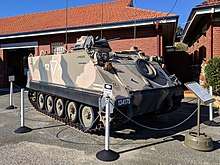
As an interim measure to improve protection, 19 M113A1s in Vietnam and one of these vehicles in Australia were fitted with Model 74C turrets between September and November 1966. These provided all-round protection, and were fitted with two M1919A4 Browning machine guns. The turret was very cramped, however, and their traverse mechanisms rapidly wore out. All of the Model 74C turrets had been withdrawn by December 1968.[27]
The T50 turret was selected as the standard turret for Australian M113s. Trials of these turrets began in April 1966, and the design was approved for service in late 1966.[28][29] M113A1s fitted with T50 turrets began to arrive in South Vietnam in August 1968. Almost all of the Australian Army's M113A1s were eventually fitted with these turrets. The turret was initially armed with two L3A3 machine guns (an improved version of the M1919A4), but some were later fitted with a M2 Browning and an M1919A3.[28] The turret was regarded as unsatisfactory by soldiers, as it was cramped and it proved difficult to keep the guns aimed when the vehicle was moving. The turret was also very slow to rotate, which led to delays in engaging targets. To free up space, the right-hand side L3A3 machine gun was removed from all the T50 turrets by early 1970; these guns were instead fitted to the roof of the turret using a pintle mount.[28] The Australian Army is one of only two M113 operators to have fitted turrets to the type.[30]
Combat experience also led to improvements to better protect M113s against land mines. From July 1969, an armoured plate was welded to the sponson above the first three roadwheels on each side of vehicles. This modification was eventually fitted to all Australian M113s.[31] From May 1970, all of the Army's M113s were also fitted with a shock-absorbing footrest for the driver.[32] Finally, a 38 mm thick aluminium armoured plate was installed on the underside of all M113s starting from August 1970. While the plate added an extra 680 kilograms (1,500 lb) in weight, this was considered acceptable given the improvement to crew protection.[33]
In 1969 three M113A1s were modified in South Vietnam to dedicated mine exploders. These vehicles were fitted with a boom of truck tires on each side, which were used detonate mines. They were also later modified so that they could be driven from their turret. The APCs were operated by the 1st Field Squadron, which nicknamed-them Her Majesty's APC (HMAPC) Flint, HMAPC Steele and HMAPC George. These vehicles proved successful in helping to clear a large barrier minefield which had originally been laid by Australian forces but was being used as a source of mines by the Communist forces.[34]
Fire support vehicles
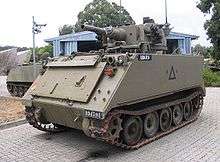
Experience in South Vietnam led to the development of fire support variants of the M113 armed with medium-calibre guns. These variants were unique to Australia.[24]
The initial M113A1 Fire Support Vehicles were fitted with the turret from an Alvis Saladin armoured car. This turret was armed with a 76 mm L5A1 gun which could fire high explosive, canister and smoke rounds. A total of 15 of this variant were produced, using all of the Australian Army's Saladins.[24] The M113A1 Fire Support Vehicles began to be produced in 1970. These vehicles were converted from newly-acquired M113A1s, with the installation of the turret and armament being undertaken by 4 Base Workshop RAEME at Bandiana, Victoria.[35]
The development of a second tranche of fire support vehicles began in 1972, when a requirement for further such AFVs was issued. It was decided that the new AFV would use the turret of a FV101 Scorpion fitted to the chassis of a M113A1 APC. The prototype vehicles began to be constructed by the Ordnance Factory in Maribyrnong, Victoria during 1974, with three being completed in mid-1975.[36] The design was approved for production in 1978, and 45 additional fire support vehicles were eventually completed by converting newly-acquired M113A1s. The type was later designated the Medium Reconnaissance Vehicle.[37]
Post-Vietnam modifications
Despite the T50 turret's shortcomings, it remained in service with all of the M113A1 APCs for over 30 years. A number of minor modifications were made to improve the turret's performance, but it was never considered genuinely satisfactory.[29] For instance, the turret lacked predictive gunsights and had no integral night vision capabilities.[38] An improved variant of the turret was developed during 1990 and early 1991; this design sought to address problems with the weapons mounting, gunsight, ammunition feed system. The variant also had improved elevation and transverse systems.[39]
In the late 1980s, several M113A1 LRVs were modified to carry RASIT ground surveillance radars and AN/TAS 6A Thermal Imaging Units. These vehicles were assigned to the 2nd Cavalry Regiment's Surveillance Troop.[40]
Other variants
Between February and May 1965 a M113 command and reconnaissance vehicle on loan from the US Army was trialled near Innisfail, Queensland. Two command and reconnaissance variants of the M114 armored fighting vehicle had previously been trialled in early 1964. These trials produced mixed results, and it was decided to not purchase either AFV.[41]
During 1967 a M113A1 in South Vietnam was fitted with a 7.62 mm GAU-2B/A Minigun on an experimental basis. The gun was mounted on the commander's cupola. This was undertaken to improve the vehicle's firepower. The gun proved unsatisfactory, as it was very difficult to accurately aim and keep supplied with ammunition. The problems with aiming the gun meant that it could not be safely used to support infantry. It was also judged that few targets the Australian Army was likely to encounter required this much firepower. As a result, the project was abandoned.[31]
In late 1971 a mine-damaged M113A1 was converted to a mechanical training aid. This comprised the forward section of the vehicle which was mounted on a stand so that instructors and students could easily observe its mechanical layout.[42]
Numbers
The total numbers of M113s acquired by the Australian Army differ between sources:
| Variant | Acquired[43] | Cecil[43] | Houston & Handel[44] | Notes |
|---|---|---|---|---|
| M113 APC | 1962 | 2 | Used for trials | |
| M113A1 APC | 1965–78 | 508 | 476 | Two converted to FSVs[43] |
| M113A1 Fitters | 1965–73 | 41 | 41 | |
| M125A1 | 1965–75 | 23 | 22 | |
| M577A1 | 1965–74 | 58 | 70 | |
| M113A1 FSV | 1969 | 15 | 15 | Included one M113A1 purchased in 1965.[43] |
| M548 TLC | 1970–79 | 103 | 103 | |
| M806A1 ARVL | 1971–73 | 19 | 19 | |
| M113A1 MRV | 1972–73 | 48 | 48 | |
| Totals | 817 | 840 |
M113AS4 family
M113 upgrade program
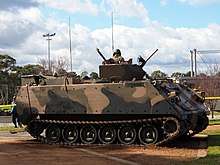
A project to replace the M113s began in the 1980s, but was abandoned in favour of upgrading the type. In October 1980 the Army initiated Project Waler which aimed to replace the M113s with new light armoured vehicles by the mid 1990s. Between 500 and 1,000 AFVs were to be procured, with the Army considering both wheeled and tracked armoured vehicles.[45] A total of 14 companies submitted proposals to the target study phase of the project, which closed in February 1982, and three were selected for further consideration in July that year; each of these proposals comprised four wheeled and tracked options.[46] Project Waler was cancelled in July 1985, with the government deciding to upgrade the M113 fleet instead. Minister for Defence Kim Beazley stated that while the designs under consideration for Project Waler would have been superior to the M113, they would be very costly to procure. The Canberra Times reported that it had also proven difficult to tailor the designs to Australian conditions and that the government regarded these AFVs as being unsuitable to Australia's needs.[47]
Work on the upgrade project began in the early 1990s. The 1992 Defence Review found that the M113 fleet could remain viable until 2010 if the vehicles were upgraded. This finding was generally supported within the Army, though there were concerns over whether it would be economic to retain the M113s until 2010.[14] The Department of Defence agreed to a limited upgrade of 537 M113A1s in October 1992, and the government approved the project in November the next year.[30]
In 1994 the Army agreed to split the project into two phases. Under Phase 1 the vehicles' suspension and engine cooling systems would be upgrade to M113A2 standard and they would be fitted with a new turret, spall liners and a cooled drinking water system. Night-vision goggles would also be acquired for M113 drivers and commanders. As part of Phase 2, the vehicles would be upgraded further to M113A3 standard, which would involve fitting them with a new engine, a new transmission system, appliqué armour and a climate control system.[48] Tenix Defence was selected as the prime contractor for Phase 1, with the contract being signed in May 1997.[49] In November 1997 Tenix proposed combining both phases of the upgrade program.[50] The Department of Defence accepted this proposal, but further design and developmental work demonstrated that the intended savings from combining the phases would not eventuate. As a result, the project was cancelled in October 2000.[51]
The 2000 Defence White Paper included a commitment to upgrade 350 M113s to improve their capabilities and retain the type in service until around 2020.[51] As part of the development of a business case for the upgrade, consideration was given to replacing the M113s with infantry fighting vehicles (IFVs) such as the American M2 Bradley. These AFVs were judged to be too expensive and too difficult to deploy.[52] Cabinet approved the M113 Major Upgrade Project in June 2002, and a contract was signed with Tenix the next month.[53] While it was intended that the upgraded M113s would begin to enter service in the second half of 2006, technical problems with the prototype vehicles led to delays.[54] These delays were in addition to those caused by problems with managing the upgrade project, which was subjected to extensive criticism in a 2005 Australian National Audit Office report.[38] In 2008 the government approved the upgrade of a further 81 M113s, taking the total to 431.[55]
The Department of Defence accepted the first upgraded M113s in November 2007. The next year the Parliamentary Secretary for Defence Procurement announced that the technical problems affecting the vehicles had been resolved, and the upgrade project had been removed from the Defence Projects of Concern List.[55] The last upgraded M113 was accepted in September 2012.[56]
The M113s which were not upgraded were disposed of. In 2000 a M113A1 which had been deployed to South Vietnam, Rwanda and East Timor was transferred to the Australian War Memorial.[57] The Memorial later received a M577A1.[58] As of 2016, a further 201 M113s were to be scrapped and 31 preserved for heritage purposes.[59]
Variants
The upgrade program involved seven variants:[44][60]
| Variant | Number built[44] | Notes |
|---|---|---|
| M113AS4 Armoured Personnel Carrier | 252 | Fitted with a T150F turret, which replaced the T50 turret.[61] The turret is armed with a M2 HB Quick Change Barrel (QCB) 12.7mm machine gun, and is electrically powered and fitted with a day/night gun sight.[38] |
| M113AS3 Armoured Personnel Carrier (Ambulance) | 15 | Carries medical equipment and wounded personnel.[62] |
| M125AS4 Armoured Mortar[63] | 21 | |
| M113AS3 Armoured Command Vehicle | 43 | |
| M113AS4 Armoured Personnel Carrier (Fitters) | 38 | Has a more powerful crane than the M113A1 Fitters vehicle's to be able to lift the upgraded M113s' heavier engine.[62] |
| M806AS4 Armoured Recovery Vehicle Light[63] | 12 | Equipped with a more powerful winch than the M806A1 Armoured Recovery Vehicle Light.[62] |
| M113AS4 Armoured Logistics Vehicle | 50 | None of the M548s were upgraded. This variant was built by extending M113A1 hulls.[23] |
All of the variants other than the Armoured Recovery Vehicle Light were built on extensively upgraded M113A1 APC hulls. The M806AS4 Armoured Recovery Vehicle Lights were converted from the M806A1 Armoured Recovery Vehicle Lights.[62] All AS4 variants have the hulls being lengthened with the addition of an extra road wheel.[48] Common upgrades to all variants include new suspension, a new power pack and engine, the addition of spall liners and appliqué armour, increased external stowage and the fuel tanks being moved from inside to outside the hull.[61] All upgraded vehicles have been fitted with new T150F tracks and sprockets.[64] The height and width of the AFVs was also increased. These modifications added 2.5 tonnes of weight for the AS3 variants and up to 5.5 tonnes for the AS4 variants. A result of the modifications was that the AFVs could no longer be transported by air or road without some elements being disassembled, and fewer could be carried on ships.[65] The AFVs also lost their amphibious capabilities.[38]
In 2019 two M113AS4 APCs were converted to optionally crewed combat vehicles by BAE Systems Australia. These vehicles were used by the Army for trials to improve its understanding of how uncrewed vehicles could be used, with the head of the project stating that "we are using M113s because we have them in service and we understand them really well".[66]
Operational history
Vietnam War
Numbers deployed
M113s were extensively used by the Australian Army during the Vietnam War. M113A1, M113A1 Fitters vehicle, M577A1, M125A1 and M113A1 FSV were deployed to South Vietnam where they were employed in a wide range of roles.[67]
A troop of eight M113A1s from the 4th/19th Prince of Wales's Light Horse was assigned to the first Australian combat unit to deploy to South Vietnam, the 1st Battalion, Royal Australian Regiment (1 RAR), and left Australia in May 1965. Two other M113A1s were allocated to this force as a reserve. Further M113A1s and two M125A1 mortar carriers were dispatched in September that year.[16]
The APC force in South Vietnam was expanded to a squadron in 1966; this force was initially designated the 1st Armoured Personnel Carrier Squadron and was renamed A Squadron, 3rd Cavalry Regiment in September 1967.[16] At the time the 1st Armoured Personnel Carrier was established, the M113 fleet in South Vietnam was increased, with M113A1 Fitters variants and M577A1 Armoured Command Vehicles joining the force.[68] The squadron was redesignated B Squadron, 3rd Cavalry Regiment in mid-1969 and A Squadron, 3rd Cavalry Regiment in April 1971.[69] While infantry units rotated in and out of South Vietnam as formed bodies, RAAC personnel were posted individually.[70]
The cavalry squadron usually comprised a squadron headquarters, three cavalry troops, a support troop and a Light Aid Detachment. Each of the cavalry troops was equipped with 12 M113A1s, and was organised into a headquarters with four APCs and three sections each with three APCs.[33] The tank squadron which also formed part of the 1st Australian Task Force was allocated two M113A1 APCs, three M113A1 Fitters vehicles and a M577A1 Armoured Command Vehicle which supported the Centurion tanks.[71] During the final stage of the withdrawal of Australian forces from South Vietnam, the cavalry squadron was reduced to a single troop equipped with 12 M113A1s, 6 Fire Support Vehicles, 2 M125s and a M577 from December 1971. The role of this troop was to protect the Australian logistics base at Vung Tau.[72] The last Australian M113s left South Vietnam in May 1972.[13]
Overall, 200 M113s were deployed to South Vietnam. This made the type the most numerous armoured fighting vehicle used by the Australian Army during the war.[73] The M113s were returned to Australia to be rebuilt after reaching a set mileage; only three were deployed twice.[74]
M113 variants deployed to South Vietnam[75]
| Variant | Number deployed |
|---|---|
| M113A1 | 163 |
| M113A1 Fitters | 11 |
| M125A1 | 10 |
| M577A1 | 8 |
| M113A1 FSV | 8 |
Employment
The M113A1s were mainly used as armoured personnel carriers, and transported troops in and out of battle.[33] In this role they were able to carry an infantry section with all of its combat equipment.[76] The Battle of Long Tan on 18 August 1966 was the first major engagement involving Australian M113A1s. During this battle a troop of APCs carrying a company of infantry played a key role in preventing another Australian infantry company from being overrun.[77]
M113A1s operated in other roles. These included escorting convoys, conducting independent patrols and carrying supplies. They were also employed in ambushes and cordon and search operations. The M113A1s supported artillery units by transporting L5 Pack Howitzers internally and towing the larger M2A2 Howitzers.[33] During the later years of the Australian deployment to South Vietnam, when 1ATF's area of operations was largely secure, groups of M113A1s frequently operated without infantry in a reconnaissance role.[78] M113A1s proved to be highly effective, as they provided mobility, protection and firepower to support infantry operations. However, their thin armour left them vulnerable to mines and other anti-tank weapons.[13][79]
M125A1 mortar carriers were usually used to provide fire support for the infantry with their 81mm mortar. They were also often employed as armoured personnel carriers.[80]
The M113A1 Fitters variants were assigned to the light aid detachments which formed part of cavalry and tank squadrons. They were operated by Royal Australian Electrical and Mechanical Engineers personnel, and were heavily employed at both Australian Army bases and in the field during operations. The variant's crane proved particularly useful.[81]
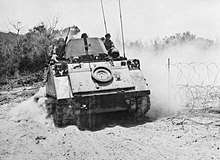
Each cavalry and tank squadron headquarters was assigned a single M577A1, and a further five were allocated to the headquarters of 1ATF.[24] 547 Signal Troop, 1ATF's signals intelligence element, was assigned an M577A1 from late 1968 and used it to support large-scale operations.[82] The radio-fit outs differed between M577A1s depending on their assigned role.[81] The M577A1s were often stationed at fire support bases, and were rarely used in patrols and convoy escort tasks.[24]
The first M113A1 FSVs arrived in Vietnam during July and August 1971, and were initially used to establish a fire support troop in A Squadron, 3rd Cavalry Regiment.[35] Six were allocated to the squadron, and two others were held in reserve.[24] After the Centurion tanks were withdrawn in September 1971, the FSVs were assigned to support infantry units.[83] They were used for patrols, protecting land-clearing teams and defending fixed positions, and typically operated with M113A1s.[81] The FSVs proved unsatisfactory, as they were lightly armoured, prone to throwing tracks and became bogged more easily than standard M113s. The FSVs also lacked gun sights for their main armament during the first months of their deployment.[84] 1ATF soon concluded that the FSVs were almost useless, and they never saw combat. The vehicles were withdrawn from South Vietnam in February 1972.[85]
Many of the M113s deployed to South Vietnam were damaged, most frequently by mines. In many cases the damage could be repaired in theatre, but 23 M113A1s and a M125A1 were written off. The hulls of most these AFVs were shipped back to Australia for disposal. A further 28 M113s were returned to Australia for repair after incurring damaged which was beyond the capabilities of the Army workshops in South Vietnam to handle. Of these M113s, 15 had sustained such serious damage that they needed to be rebuilt using newly-purchased hulls.[74] The cavalry squadron incurred significant casualties, with 20 of its members being killed (including 17 killed in action) and 110 seriously wounded in action; this represented approximately one in seven of its members. Many others suffered minor injuries.[86]
Extensive training was undertaken in Australia to prepare soldiers and units for service in South Vietnam. During 1969 alone M113s in Australia were driven for 530,000 miles (850,000 km) during training.[87] Soldiers were trained by the squadron of the 3rd Cavalry Regiment which was stationed in Australia at the time immediately before being posted to the squadron in South Vietnam.[88]
After Vietnam
In mid-1970 the M113A1 fitted with a T50 turret was selected as the standard vehicle for all RAAC units other than the armoured regiments. The CMF RAAC units were authorised eight M113A1s to replace their obsolete armoured cars, as well as a single M577A1 armoured command vehicle.[89] Deliveries of these M113s were completed in 1972. By this time, all the CMF RAAC units had been organised as cavalry or APC formations.[90] The M113A1 FSVs were used by regular cavalry regiments and the Armoured Centre until 1979, when they were transferred to Army Reserve units.[91]
The Australian Army began to develop a mechanised infantry capability during the late 1970s. The 5th/7th Battalion, Royal Australian Regiment (5/7 RAR) began trialling mechanised tactics beginning in 1976.[13] This reform aimed to improve the mobility of the unit, and make better use of the capabilities of the APCs. The battalion was fully mechanised by mid 1977; in this role it was equipped with 72 M113s.[92] Following the Sydney Hilton Hotel bombing in February 1978, 5/7 RAR's M113s were stationed along the Hume Highway to protect national leaders as they travelled from Sydney to Bowral for the Commonwealth Heads of Government Meeting.[93] There was scepticism within Army Headquarters over the cost-effectiveness of mechanisation and the viability of maintaining only a single mechanised battalion. At the conclusion of the mechanisation trial in mid-1978, only one company of 5/7 RAR was retained as a mechanised unit with the others reverting to light infantry.[94]
In early 1983 a decision was made to permanently convert 5/7 RAR to a fully mechanised unit. The battalion transitioned to this role between July 1983 and 1984. Some supporting elements of the 1st Brigade were also mechanised.[95] 5/7 RAR had completed its transformation to a mechanised battalion by 1986; as of early that year, it was equipped with 56 M113A1 APCs, 4 M125A1s, 4 M113A1 Fitters vehicles, 3 M557A1s, 1 M113 Armoured Recovery Vehicle Light and 7 tracked load carriers. The battalion cooperated closely with the 1st Armoured Regiment and a troop of mechanised engineers which was established within the 1st Field Squadron.[96]
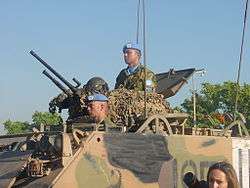
The M113 fleet saw some changes over the 1980s and 1990s. All of the Army's M113A1s were "grounded" between September 1982 and July 1983 due to serious problems affecting their control differential. This greatly disrupted training activities.[97] The M113A1 FSVs were retired in 1986, and six of the vehicles were sold to the New Zealand Army after being converted back to standard M113A1s.[91] The 1987 Defence White Paper called for the number of M113s to be reduced to below 600, with some of the remaining vehicles being upgraded. The White Paper also recommended that the 2nd Cavalry Regiment's M113s be replaced with wheeled vehicles.[98] The ASLAV was selected for this role in 1992.[99] The 2nd Cavalry Regiment was converted to ASLAVs during 1995 and 1996.[100] The M113A1 MRVs were withdrawn from service in late 1996 due to shortages of spare parts for their turrets and concerns that the fumes ejected when their main gun was fired were toxic.[101]
In 1993 B Squadron, 3/4th Cavalry Regiment was deployed to Somalia to support 1 RAR during Operation Solace. The unit was equipped with 36 M113A1 variants, including 28 APCs and two M125A1 mortar carriers.[102] This deployment proved successful, with the vehicles being used in similar roles to those they had performed during the Vietnam War.[103] However, the squadron had difficulty maintaining the M113s, particularly due to a shortage of links for their caterpillar tracks.[13]
Three M113A1 APCs and a M113A1 fitters vehicle were deployed to Rwanda between 1994 and 1995. These vehicles were used to protect Australian Army medical teams operating in the country.[104]
In September 1999, B Squadron, 3/4th Cavalry Regiment was deployed to East Timor as part of the INTERFET peacekeeping mission. The unit supported light infantry units, and its M113s proved better suited to conditions in East Timor than the 2nd Cavalry Regiment's ASLAVs. 5/7 RAR was subsequently deployed to East Timor and proved highly effective. Australian M113s remained in East Timor until 2002 to support the infantry battalions deployed there.[48]
Plan Beersheba

The number of mechanised infantry units was increased in 2007 when 5/7 RAR was de-linked. Both the 5th Battalion, Royal Australian Regiment and 7th Battalion, Royal Australian Regiment (7 RAR) operated in the mechanised role until 2013, when they converted to light infantry as part of the Plan Beersheba restructure.[13] As part of this restructure, each of the Army's three brigades included two light infantry battalions which could access a squadron of M113s in the brigade's armoured cavalry regiment.[105] This structure proved short-lived, and the 3rd Battalion, Royal Australian Regiment, 6th Battalion, Royal Australian Regiment and 7 RAR began converting to mechanised infantry units in 2018.[106] This change was an interim measure to prepare infantry units to operate IFVs ahead of these vehicles being ordered and delivered.[107]
No M113s have been deployed to Afghanistan as part of the long-running Australian operations there the Army considered them to be too vulnerable.[108] In 2010 the Department of Defence advised a parliamentary committee that the upgraded M113s would require additional protection to be able to serve in Afghanistan, and that ASLAVs and Bushmaster Protected Mobility Vehicles were best suited to conditions there.[109] The department also noted that it was unlikely that the M113s would ever be deployed to "a place where there is sustained close combat expected on a daily basis".[110]
Replacement
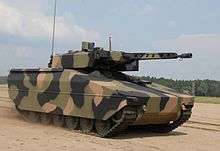
As part of the LAND 400 project, the Australian Government is currently seeking IFVs to replace the M113s from 2025. The Army believes that the M113s are "not expected to be deployable for anything other than low intensity/low risk missions beyond 2025", and will reach the end of their service life in 2030.[111] The introduction of IFVs will give the Australian Army a new capability, and better enable it to take part in high intensity warfare.[112]
A request for tender for IFVs was issued in mid-2018. At this time, it was intended to acquire up to 450 IFVs and 17 manoeuvre support vehicles.[113] In September 2019, Hanwha Defense Australia's AS21 Redback and Rheinmetall Defence Australia's Lynx IFVs were selected for further evaluation.[114] A decision on the type of IFV to be purchased is scheduled to be made in 2022.[115]
References
Citations
- Grey 2001, pp. 204–205.
- Grey 2001, p. 207.
- Hopkins 1978, pp. 218–219.
- Australian Army 1960b, p. 10.
- Australian Army 1960a, pp. 14–17.
- Australian Army 1960b, p. 8.
- Coates 2002, p. 80.
- Handel 1998, p. 26.
- Cecil 2009, p. 80.
- Cecil 2011, p. 48.
- Cecil 2011, pp. 48–49.
- Cecil 2011, p. 49.
- Houston & Handel 2015, p. 2.
- Australian National Audit Office 2005, p. 24.
- Hopkins 1978, pp. 346–347.
- Cecil 2009, p. 81.
- Coates 2002, p. 81.
- Hopkins 1978, p. 225.
- Handel 1998, p. 28.
- Hopkins 1978, p. 216.
- Australian National Audit Office 2005, p. 11.
- Cecil 2009, pp. 81, 83.
- Australian National Audit Office 2009, p. 28.
- Cecil 2009, p. 83.
- Hopkins 1978, p. 299.
- Cecil 2009, p. 84.
- Cecil 2009, pp. 84–85.
- Cecil 2009, p. 87.
- Handel 1998, p. 37.
- Australian National Audit Office 2005, p. 25.
- Cecil 2009, p. 88.
- Cecil 2009, pp. 88, 91.
- Cecil 2009, p. 91.
- Cecil 2009, p. 105–107.
- Handel 1998, p. 46.
- Handel 1998, p. 54.
- Handel 1998, p. 57.
- Toal, Mick (1 October 2007). "Land Warfare 2007: New life for old warhorse". Australian Defence Magazine. Retrieved 21 September 2019.
- Handel 1998, p. 74.
- Handel 1998, p. 71.
- Handel 1998, pp. 28–29.
- Handel 1998, p. 48.
- Cecil 2009, p. 141.
- Houston & Handel 2015, p. 3.
- Handel 1998, p. 59.
- Handel 1998, p. 60.
- Cranston, Frank (25 July 1985). "Plans for new army vehicles deferred". The Canberra Times. p. 9. Retrieved 21 September 2019 – via National Library of Australia.
- Houston & Handel 2015, p. 4.
- Australian National Audit Office 2005, pp. 32–33.
- Australian National Audit Office 2005, p. 26.
- Australian National Audit Office 2012, p. 55.
- Joint Committee of Public Accounts and Audit 2010, p. 31.
- Australian National Audit Office 2005, pp. 26–27.
- Australian National Audit Office 2012, pp. 55–57.
- Australian National Audit Office 2012, p. 57.
- Department of Defence 2012, p. 143.
- "M113A1 Armoured Personnel Carrier and Light Reconnaissance vehicle". Collection. Australian War Memorial. Retrieved 15 December 2019.
- Australian National Audit Office 2016, p. 39.
- Australian National Audit Office 2016, p. 37.
- Australian National Audit Office 2012, p. 67.
- Australian National Audit Office 2005, p. 13.
- Australian National Audit Office 2009, p. 37.
- "Land Warfare Doctrine 3-3-4 Employment of Armour 2016" (PDF). Australian Army. 11 November 2016. p. 21. Retrieved 22 November 2019.
- "BAE supplying vehicle upgrade parts". United Press International. 8 October 2010. Retrieved 21 November 2019.
- Australian National Audit Office 2005, p. 28.
- Robards, Carrie (14 November 2019). "Programmed for the future" (PDF). Army. p. 2. Retrieved 15 November 2019.
- Cecil 2009, pp. 81–83, 91.
- Cecil 2009, pp. 81–83.
- Handel 1998, p. 41.
- McKay & Nicholas 2001, p. 9.
- Cecil 2009, p. 145.
- Anderson 2002, p. 280.
- Cecil 2009, p. 35.
- Cecil 2009, p. 112.
- Cecil 2009, p. 282.
- McKay & Nicholas 2001, p. 7.
- McKay & Nicholas 2001, p. 13.
- McKay & Nicholas 2001, pp. 12–13.
- Anderson 2002, pp. xiv–xv.
- Cecil 2009, pp. 89–93.
- Cecil 2009, p. 93.
- Blaxland 2012, p. 35.
- Ekins & McNeill 2012, p. 599.
- Ekins & McNeill 2012, pp. 536, 600.
- Ekins & McNeill 2012, pp. 601–602.
- Anderson 2002, pp. 282–283.
- Handel 1998, p. 42.
- "3 Cavalry Regiment". Australian War Memorial. Retrieved 15 December 2019.
- Handel 1998, p. 44.
- Handel 1998, p. 50.
- Handel 2012.
- Pedersen 2008, p. 250.
- Pedersen 2008, p. 251.
- Pedersen 2008, p. 252.
- Horner 2008, p. 271.
- Horner 2008, p. 272.
- Handel 1998, p. 63.
- Handel 1998, p. 68.
- Handel 1998, p. 73.
- Handel 1998, p. 80.
- Handel 1998, p. 82.
- Handel 1998, p. 76.
- Handel 1998, p. 77.
- Handel 1998, p. 79.
- Carpenter, Jeremy (5 July 2019). "Plan Beersheba, LAND 400 and a third way". Defence Connect. Retrieved 16 November 2019.
- "Bulletin of The Royal Australian Regiment Foundation" (PDF). Royal Australian Regiment Foundation. October 2018. pp. 16, 22, 25. Retrieved 16 November 2019.
- Holloway, Lt Col John (15 June 2017). "Combat brigades embrace changes" (PDF). Army. Department of Defence. p. 11. ISSN 0729-5685. Retrieved 3 January 2019.
- Young, Matt (14 March 2018). "Australian Army set for a massive overhaul of fighting vehicles in 'discrete' reequipment megaproject". news.com.au. Retrieved 16 June 2019.
- Joint Committee of Public Accounts and Audit 2010, p. 29.
- Joint Committee of Public Accounts and Audit 2010, p. 30.
- "Project LAND 400". Australian Army. Retrieved 16 November 2019.
- Sullivan, Declan (21 November 2018). "Infantry fighting vehicles will complete Australia's armoured forces". The Strategist. Australian Strategic Policy Institute. Retrieved 16 November 2019.
- Hartigan, Brian (24 August 2018). "M113 replacement project starts". Contact. Retrieved 16 November 2019.
- Kerr, Julian (19 September 2019). "The reasons behind the Land 400 Phase 3 decision". Australian Defence Magazine. Retrieved 16 November 2019.
- "Land Combat Vehicle System". Department of Defence. Retrieved 16 November 2019.
Bibliography
| Wikimedia Commons has media related to M113 armored personnel carriers in Australian service. |
- Anderson, Paul (2002). When the Scorpion Stings: The History of the 3rd Cavalry Regiment, South Vietnam, 1965–1972. Crows Nest, New South Wales: Allen & Unwin. ISBN 978-1-86508-743-6.CS1 maint: ref=harv (link)
- Australian Army (February 1960a). "The Pentropic Division: Armour" (PDF). Australian Army Journal (129): 14–17. OCLC 223637032.CS1 maint: ref=harv (link)
- Australian Army (June 1960b). "The Pentropic Division: Armour in the Combat Support Group" (PDF). Australian Army Journal (133): 6–13. OCLC 223637032.CS1 maint: ref=harv (link)
- Australian National Audit Office (2005). Management of the M113 Armoured Personnel Carrier Upgrade Project (PDF). Canberra: Australian National Audit Office.CS1 maint: ref=harv (link)
- Australian National Audit Office (2009). Management of the M113 Armoured Personnel Carrier Upgrade Project (PDF). Canberra: Australian National Audit Office.CS1 maint: ref=harv (link)
- Australian National Audit Office (2012). Upgrade of the M113 Fleet of Armoured Vehicles (PDF). Canberra: Australian National Audit Office.CS1 maint: ref=harv (link)
- Australian National Audit Office (2016). Reforming the Disposal of Specialist Military Equipment (PDF). Canberra: Australian National Audit Office. ISBN 978-1-76033-188-7.CS1 maint: ref=harv (link)
- Blaxland, John (2012). "Listening to the Enemy". Wartime (57): 30–35. ISSN 1328-2727.CS1 maint: ref=harv (link)
- Cecil, Michael K. (2009). Mud & Dust: Australian Army Vehicles & Artillery in Vietnam. Chatswood, New South Wales: New Holland. ISBN 978-1-74110-767-8.CS1 maint: ref=harv (link)
- Cecil, Michael K. (2011). "A Major Move to Mobility: Introduction of the M113A1 Family of Vehicles". In Baines, John; Branagan, Peter; Finlayson, David (eds.). The AFV School: 70 Years of Training Australian Armour. Royal Australian Armoured Corps. pp. 48–50. OCLC 711724170.CS1 maint: ref=harv (link)
- Coates, John (2002). "Preparing Armoured Units for Overseas Service". In Dennis, Peter; Grey, Jeffrey (eds.). The Australian Army and the Vietnam War 1962–1972: The 2002 Chief of Army's Military History Conference (PDF). Canberra: Army History Unit. pp. 74–95. ISBN 978-0-642-50267-4.CS1 maint: ref=harv (link)
- Department of Defence (2012). Defence Portfolio Additional Estimates Statements 2012–13 (PDF). Canberra: Department of Defence. ISBN 978-0-642-29773-0.CS1 maint: ref=harv (link)
- Ekins, Ashley; McNeill, Ian (2012). Fighting to the Finish: The Australian Army and the Vietnam War 1968–1975. The Official History of Australia's Involvement in Southeast Asian Conflicts 1948–1975. Crows Nest, New South Wales: Allen & Unwin. ISBN 978-1-86508-824-2.CS1 maint: ref=harv (link)
- Grey, Jeffrey (2001). The Australian Army. The Australian Centenary History of Defence. South Melbourne: Oxford University Press. ISBN 978-0-19-554114-4.CS1 maint: ref=harv (link)
- Handel, Paul (1998). Fifty Years of the Royal Australian Armoured Corps, 1948 to 1998. Puckapunyal, Victoria: Royal Australian Armoured Corps Memorial and Army Tank Museum.CS1 maint: ref=harv (link)
- Handel, Paul (25 April 2012). "M113A1 Fire Support Vehicle". Anzac Steel. Retrieved 16 June 2019.CS1 maint: ref=harv (link)
- Hopkins, Ronald (1978). Australian Armour: A History of the Royal Australian Armoured Corps 1927–1972. Canberra: Australian Government Publishing Service. ISBN 978-0-642-99414-1.CS1 maint: ref=harv (link)
- Horner, David (2008). "Ready Reaction and Specialisation: Australia, 1980–90". In Horner, David; Bou, Jean (eds.). Duty First: A History of the Royal Australian Regiment. Allen & Unwin. pp. 239–257. ISBN 978-1-74175-374-5.CS1 maint: ref=harv (link)
- Houston, Bill; Handel, Paul (9 April 2015). "Half a Century's Service" (PDF). Army News. Department of Defence. Retrieved 16 June 2019.CS1 maint: ref=harv (link)
- Joint Committee of Public Accounts and Audit (2010). Report 417: Review of Auditor-General's Reports tabled between February 2009 and September 2009. Canberra: Parliament of Australia. ISBN 978-0-64279-249-5.CS1 maint: ref=harv (link)
- McKay, Gary; Nicholas, Graeme (2001). Jungle Tracks: Australian Armour in Viet Nam. St. Leonards, New South Wales: Allen & Unwin. ISBN 978-1-86508-449-7.CS1 maint: ref=harv (link)
- Pedersen, Peter (2008). "The Defence of Australia: Australia, 1973–79". In Horner, David; Bou, Jean (eds.). Duty First: A History of the Royal Australian Regiment. Allen & Unwin. pp. 239–257. ISBN 978-1-74175-374-5.CS1 maint: ref=harv (link)
Further reading
- Blaxland, John (1989). Organising an Army: The Australian Experience 1957–1965. Canberra Papers on Strategy and Defence. No. 50. Canberra: Australian National University. ISBN 0-73150-530-1.